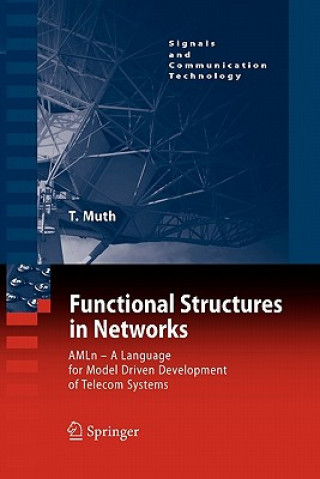
Dostawa
Doradca ds. zakupów





Jednak się nie przyda? Nic nie szkodzi! U nas możesz zwrócić towar do 30 dni
 Bon prezentowy
O dowolnej wartości
Bon prezentowy
O dowolnej wartości
Bon prezentowy to zawsze dobry pomysł. Obdarowany może za bon prezentowy wybrać cokolwiek z naszej oferty.
Functional Structures in Networks
 Angielski
Angielski
 304 b
304 b
 common.delivery_to
common.delivery_to
30 dni na zwrot towaru
Mogłoby Cię także zainteresować


Designed to make life easier for most network designers, whether they are a manager with technical background, work with standardization, the architecture of implementers solutions to standards, product design (constructing the software and hardware parts of operator networks), system testing, and for operators responsible for the configuration and maintenance of a network. §Develops modeling as a basic principle for producing specifications turns design from being document driven to model-driven. In the context of this book, however, the only model type that is discussed is the information model that describes the purpose, structure, and behavior of a network. §Presents an added-value modeling language that called AMLn (Abstract Modeling Language, network view), which is the first and, so far, the only attempt to create a modeling language for network systems.The book describes a method for creating models of telecom systems. The method is intended for practicing network architects and designers. This method emphasizes modeling the (very complex) functional structure of networks in a way that is independent of any hardware and software design methodology. The method also allows designers to express their model in two main views: a generic view and a system view that takes protocols and network configuration issues into account. The idea is to retain a stable view (the generic) in the context of constant changes and large variations within the system view. The expected benefits are large savings in telecom systems development and maintenance. The terminology is domain unique, i.e., based on de-facto telecom terminology. All concepts that are used in modeling are well defined. The purpose of using a telecom-oriented terminology instead of industry-standard methods for software and protocol design (e.g., UML and SDL) is to be able to create models that are expressive and intelligible for network architects and designers. Models are created as graphical models that show the functional and physical structure of networks at different levels of details. Information on properties, including behavior is attached to the models. A fairly small set of symbols is used in modeling.
Informacje o książce
 Angielski
Angielski
Kategoria




 Jak kupować
Jak kupować




















